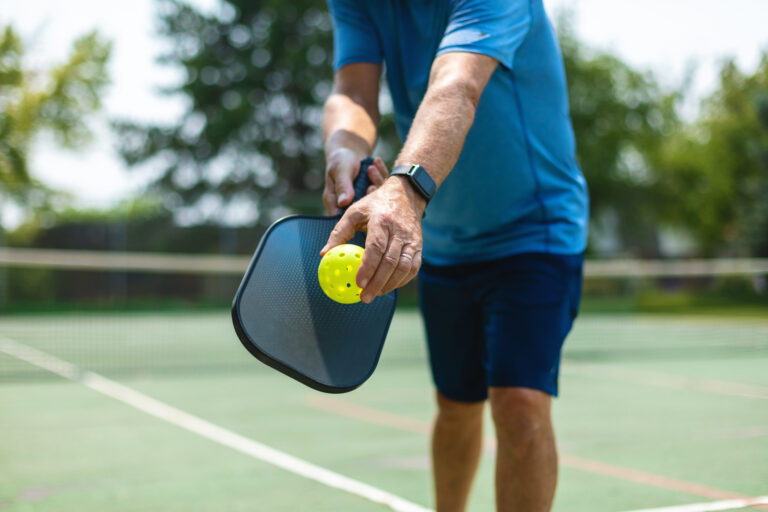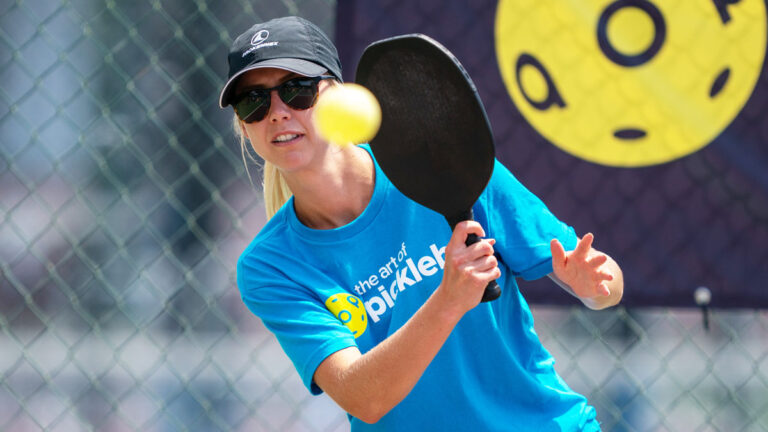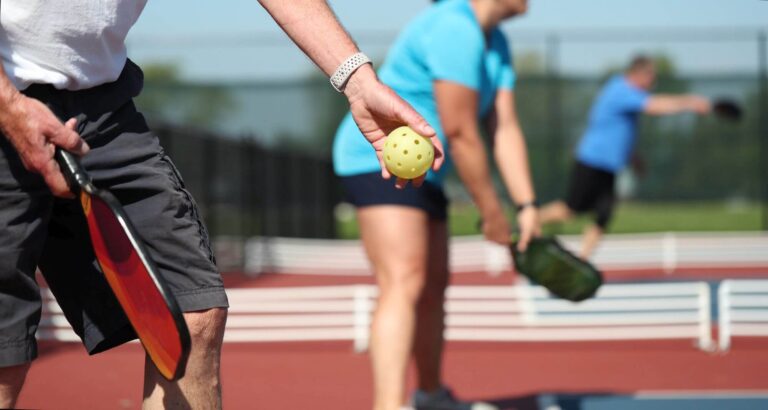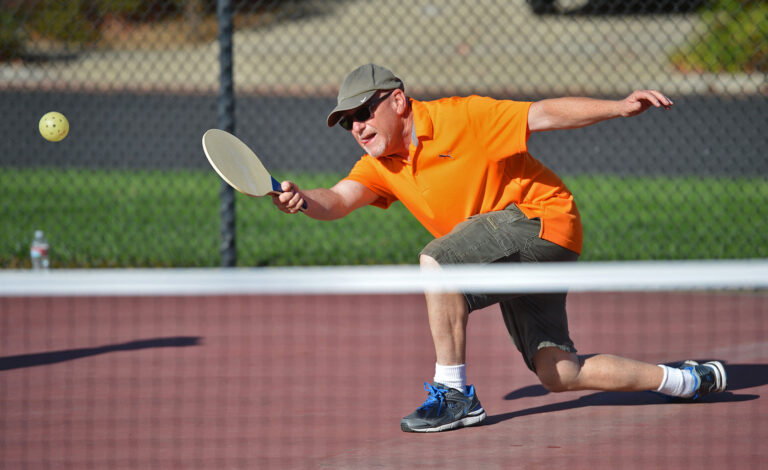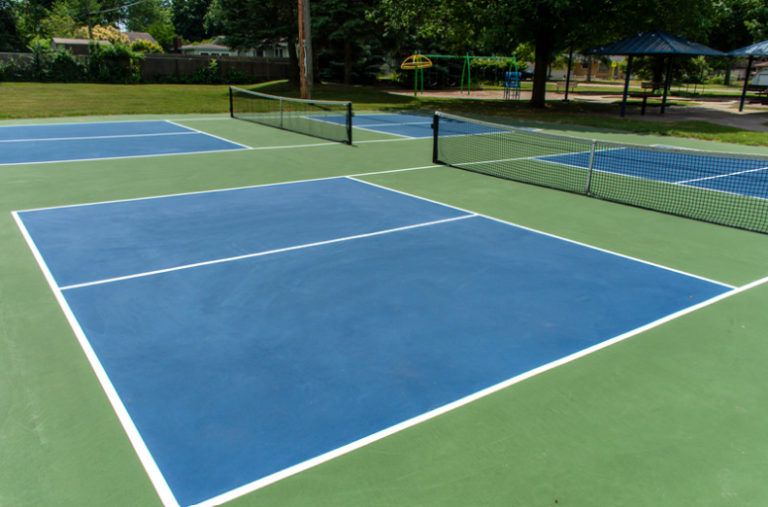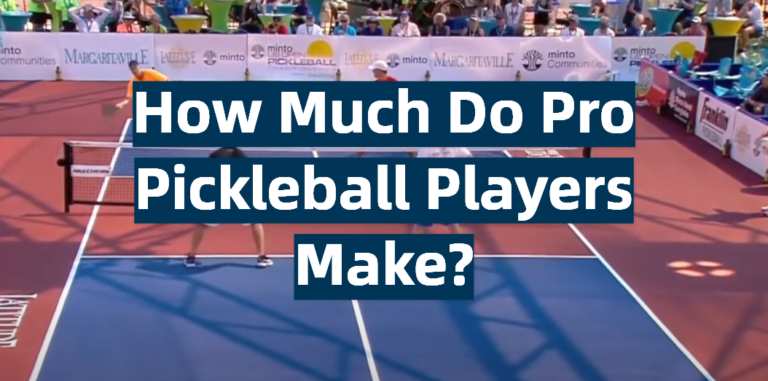Mastering the Pickleball Court: A Guide to Stacking (and What Pickleballs are Made Of!)
What is Stacking in Pickleball? Mastering Court Positioning
Stacking in pickleball is a strategic positioning technique used in doubles play where both players on a team position themselves on the same side of the court. This unconventional positioning allows players to emphasize their strengths, create challenging angles for opponents, and improve team communication and coordination. Stacking can be employed either on the serve or the return, depending on the team’s preferences and the opponents’ weaknesses. Effective stacking requires good communication, efficient movement, and the ability to adapt to the opponents’ shots.
Key Takeaways
- Stacking is a strategic positioning technique in doubles pickleball where both players position themselves on the same side of the court.
- The main benefits of stacking include emphasizing player strengths, creating challenging angles, and improving team communication and coordination.
- There are two primary types of stacking: stacking on the serve and stacking on the return.
- When deciding to stack, consider factors such as the skill level of partners, opponents’ strengths and weaknesses, and the game situation.
- Effective stacking requires clear communication, efficient movement, and the ability to adapt to your opponent’s shots.
- Pickleballs are typically made of plastic materials, with varying characteristics depending on whether they are designed for indoor or outdoor play.
- To improve your stacking skills, practice solo and partner drills, play stacking-focused games, and study the techniques of successful stacking players.
Remember, stacking is just one aspect of a well-rounded pickleball strategy. By combining effective stacking with other skills, such as shot selection, court coverage, and mental toughness, you can take your game to the next level and dominate on the pickleball court.
What is Pickleball?
Before we dive into stacking, let’s briefly cover the basics of pickleball for those who are new to the sport. Pickleball is a paddle sport that combines elements of badminton, tennis, and table tennis. It’s played on a court that’s smaller than a tennis court, with a net that’s slightly lower. Players use solid paddles to hit a perforated plastic ball, similar to a wiffle ball, over the net. The objective is to score points by forcing your opponent to fail to return the ball or by hitting the ball out of bounds.
Here are some key facts about pickleball:
- Invented in 1965 by Joel Pritchard, Bill Bell, and Barney McCallum
- Played on a 20′ x 44′ court for both singles and doubles
- Net height is 36″ at the sidelines and 34″ in the middle
- Serves must be underhand and diagonal, starting with the right-hand service square
- Points are only scored by the serving team
What is Stacking in Pickleball?
Stacking is a strategic positioning technique used in doubles pickleball. In traditional doubles positioning, partners stand on opposite sides of the court, with one player on the right and the other on the left. However, when stacking, both players position themselves on the same side of the court, either on the right or the left. This unconventional positioning can catch opponents off guard and create unique opportunities for the stacking team.
The primary goal of stacking is to maximize each player’s strengths while minimizing their weaknesses. For example, if one player has a particularly strong forehand, they may choose to stack on the right side of the court, allowing them to cover more of the court with their dominant shot. By positioning themselves strategically, players can create challenging angles for their opponents and force them to hit into their strengths.
Benefits of Stacking
Stacking offers several key advantages for doubles teams:
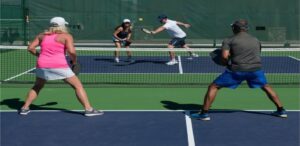
- Emphasizing player strengths: By positioning players on their preferred side of the court, stacking allows them to utilize their strongest shots more frequently. For example, a right-handed player with a powerful forehand may choose to stack on the right side, giving them more opportunities to hit forehand shots.
- Creating challenging angles: Stacking can create unique angles that are difficult for opponents to defend. When both players are positioned on the same side of the court, they can hit shots that cross the court diagonally, forcing opponents to cover more ground and hit awkward returns.
- Improving team communication and coordination: When partners stack, they are closer together on the court, making it easier to communicate and coordinate their movements. This proximity can lead to better teamwork and more efficient coverage of the court.
| Benefit | Description |
|---|---|
| Emphasizing player strengths | Positioning players on their preferred side of the court to utilize their strongest shots more frequently |
| Creating challenging angles | Hitting shots that cross the court diagonally, forcing opponents to cover more ground and hit awkward returns |
| Improving team communication and coordination | Being closer together on the court, making it easier to communicate and coordinate movements |
When to Use Stacking in Pickleball
Stacking can be effective in various situations, depending on the strengths and weaknesses of both your team and your opponents. Here are some common scenarios where stacking may be advantageous:
- When one player has a dominant shot: If one partner has a particularly strong forehand or backhand, stacking can help them utilize that shot more frequently by positioning them on their preferred side of the court.
- When facing opponents with weaker backhands: If your opponents struggle with backhand shots, stacking can allow you to exploit this weakness by hitting more shots to their backhands.
- When playing against a team with a significant height difference: Stacking can be effective when playing against a team with one tall player and one short player. By stacking, you can force the taller player to hit more shots from a lower contact point, which may be less comfortable for them.
It’s important to note that stacking may not be the best strategy in every situation. If both you and your partner are comfortable with traditional doubles positioning and have strong all-around games, stacking may not provide significant benefits. Additionally, stacking requires good communication and coordination between partners, so it may not be ideal for teams who are new to playing together.
Types of Stacking
There are two primary types of stacking in pickleball: stacking on the serve and stacking on the return.

Stacking on the Serve (H3)
When stacking on the serve, the serving team positions themselves on the same side of the court before the serve. The server stands in the right-hand service box, while their partner stands in the left-hand service box. After the serve, the server’s partner will move to the opposite side of the court, while the server stays on the same side. This allows the serving team to start the point with their preferred positioning.
Stacking on the Return (H3)
Stacking on the return involves the receiving team positioning themselves on the same side of the court when receiving the serve. This can be particularly effective if one player on the receiving team has a strong forehand return. By stacking, they can ensure that they are in position to hit a forehand return, regardless of where the serve is directed.
How to Stack in Pickleball: The Basics
To execute a basic stack, follow these steps:
- Decide which side of the court each player will stack on based on their strengths and the weaknesses of the opposing team.
- Before the serve, both players position themselves on the same side of the court, with one player in the right-hand service box and the other in the left-hand service box.
- After the serve, the player in the left-hand service box moves to the opposite side of the court, while the player in the right-hand service box stays on the same side.
- As the point progresses, both players work together to cover the court effectively, using communication and coordination to ensure that all areas of the court are defended.
When stacking, it’s important to avoid common mistakes, such as:
- Failing to communicate effectively with your partner
- Not moving quickly enough to cover the court after the serve
- Stacking in situations where it’s not advantageous, such as when both players have strong all-around games
Advanced Stacking Techniques
Once you’ve mastered the basics of stacking, you can explore more advanced techniques to take your game to the next level. Here are a few variations to consider:
- Diagonal stacking: In diagonal stacking, partners position themselves diagonally across the court from each other. This can create even more challenging angles for opponents and allow players to cover the court more efficiently.
- Switching sides: In some cases, players may choose to switch sides during a point to confuse their opponents or adapt to changing conditions on the court. This requires good communication and coordination between partners.
- Fake stacking: Fake stacking involves setting up in a stacked position before the serve, but then moving to traditional doubles positioning after the serve. This can be used to confuse opponents and keep them guessing about your team’s strategy.
When facing opponents who are stacking, there are a few strategies you can use to counter their positioning:
- Hit to the middle: By hitting shots down the middle of the court, you can force stacked opponents to move more and potentially create confusion about who should hit the ball.
- Exploit the gaps: Stacking can leave gaps on the court that you can exploit with well-placed shots. Look for opportunities to hit into the open spaces created by your opponents’ positioning.
- Vary your shots: Mix up your shot selection to keep stacked opponents guessing. Use a combination of lobs, dinks, and drives to force them to adjust their positioning and movement.
Considerations for Stacking
Before deciding to stack, there are several factors to consider:
- Skill level of partners: Stacking requires good communication and coordination between partners. If you and your partner are new to playing together or have different skill levels, stacking may not be the most effective strategy.
- Opponents’ strengths and weaknesses: Consider your opponents’ playing styles and strengths when deciding whether to stack. If they have particularly strong backhands, for example, stacking may not provide a significant advantage.
- Game situation: The score and stage of the game can also influence your decision to stack. If you’re ahead and feeling confident, you may choose to stick with traditional doubles positioning. However, if you’re trailing and need to mix things up, stacking could provide a strategic advantage.
Tips for Effective Stacking
To stack effectively, keep these tips in mind:
- Communicate clearly with your partner: Good communication is essential when stacking. Make sure you and your partner are on the same page about your positioning and strategy.
- Move efficiently: After the serve, it’s important to move quickly and efficiently to cover the court. Work on your footwork and agility to ensure that you can transition smoothly from stacked to traditional positioning.
- Adapt to your opponent’s shots: Be prepared to adjust your stacking based on your opponent’s returns. If they start hitting shots that exploit the gaps created by your positioning, be ready to adapt and modify your strategy.
Stacking in Doubles vs. Singles Play
Stacking is primarily used in doubles play, as it involves coordination between two partners. In singles play, stacking is not applicable, as there is only one player per side.
However, the principles behind stacking, such as emphasizing strengths and creating challenging angles, can still be applied to singles play. In singles, you can use your positioning on the court to create advantageous angles and force your opponent to hit into your strengths.
Drills and Exercises to Improve Your Stacking Skills
To improve your stacking skills, try these drills and exercises:
- Solo stacking drill: Set up a stack on one side of the court and have a partner or ball machine feed balls to you. Practice moving from the stacked position to cover the court, focusing on your footwork and agility.
- Partner stacking drill: Work with a partner to practice stacking on both the serve and the return. Take turns serving and returning, focusing on communication and coordination as you move from stacked to traditional positioning.
- Stacking games: Play games with a partner where you are required to stack on every point. This will help you build comfort and familiarity with the positioning and movement required for effective stacking.
Famous Pickleball Players Known for Their Stacking Abilities
Many professional pickleball players have used stacking to great effect in their careers. Here are a few examples:
- Simone Jardim: Simone Jardim, a multiple-time national and international champion, is known for her versatile playing style and effective use of stacking. She often stacks with her partner, Lucy Kovalova, to create challenging angles and put pressure on their opponents.
- Matt Wright: Matt Wright, another top professional player, frequently employs stacking in his doubles play. He is known for his strong forehand and uses stacking to maximize his opportunities to hit this shot.
- Jessie Irvine: Jessie Irvine, a highly successful doubles player, often stacks with her partners to create confusion for their opponents and open up the court for attacking shots.
By studying these players and analyzing their stacking techniques, you can gain valuable insights into how to use this strategy effectively in your own game.
Frequently Asked Questions About Stacking in Pickleball
Q: Is stacking legal in pickleball?
A: Yes, stacking is a legal strategy in pickleball. There are no rules prohibiting players from positioning themselves on the same side of the court.
Q: Can you stack in singles play?
A: No, stacking is not applicable in singles play, as there is only one player per side. However, you can still use positioning strategies to create advantageous angles and target your opponent’s weaknesses.
Q: How do you know when to stack in pickleball?
A: The decision to stack depends on various factors, such as your team’s strengths, your opponents’ weaknesses, and the game situation. Good communication with your partner and a solid understanding of your own playing style are key to knowing when to stack.
Q: Can you switch from stacking to traditional positioning during a game?
A: Yes, you can switch between stacking and traditional positioning during a game. Some teams may choose to stack on certain points and play in traditional positions on others, depending on the situation.
Bonus Section: What is a Pickleball Made Of?
Now that we’ve covered the ins and outs of stacking, let’s address another common question among pickleball players: what are pickleballs made of?
Pickleballs are typically made of a plastic material, such as high-density polyethylene (HDPE) or polypropylene (PP). The ball has a perforated surface, similar to a wiffle ball, which allows it to fly through the air with less resistance than a solid ball.
The specific construction of a pickleball can vary depending on the manufacturer and the intended use of the ball (e.g., indoor vs. outdoor play). Some pickleballs have a solid plastic core, while others have a hollow core. The number and size of the perforations can also differ between models.
Here’s a table comparing the characteristics of indoor and outdoor pickleballs:
| Characteristic | Indoor Pickleball | Outdoor Pickleball |
|---|---|---|
| Material | Softer, lightweight plastic | Harder, more durable plastic |
| Perforations | Larger, fewer holes | Smaller, more numerous holes |
| Bounce | Lower, controlled bounce | Higher, more lively bounce |
| Durability | Less durable, prone to breaking | More durable, withstands outdoor play |
When selecting a pickleball, it’s important to choose a ball that is appropriate for your playing style and the conditions you’ll be playing in. Factors to consider include the ball’s durability, bounce, and flight characteristics.
Conclusion
Stacking is a powerful strategy that can give you and your partner a competitive edge on the pickleball court. By positioning yourselves strategically, you can emphasize your strengths, create challenging angles for your opponents, and improve your team’s communication and coordination.
Remember, the key to effective stacking is:
- Good communication
- Efficient movement
- Ability to adapt to your opponent’s shots
By practicing the drills and exercises outlined in this guide and studying the techniques of successful stacking players, you can take your doubles game to the next level.
So the next time you step onto the pickleball court, consider giving stacking a try. With a little practice and persistence, you may just find that this unconventional strategy is the key to unlocking your full potential as a player.
Ready to put your new stacking knowledge into practice? Follow these steps to get started:
- Grab your partner and head to the pickleball court
- Discuss your strengths and weaknesses and decide on a stacking strategy
- Practice stacking on both the serve and the return
- Focus on communication, efficient movement, and adaptability
- Have fun and enjoy the game!
If you’re looking for more pickleball tips, strategies, and gear recommendations, be sure to check out the rest of our content at pickleballtoolbox.net. We’re here to help you master the game and take your skills to new heights. Happy stacking!

